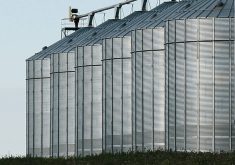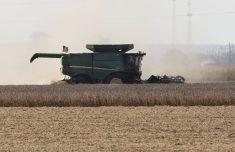Saskatchewan
Warm weather in the third week of July helped crops advance, although rain and high humidity slowed haying progress and even decreased quality.
Hay yields are slightly above the five-year average and are reported at 1.5 tons per acre for alfalfa and alfalfa-brome hay, 1.3 tons per acre for other tame hay, one ton per acre for wild hay and two tons per acre for greenfeed.
Most crops are in good to excellent condition with 12 percent surplus topsoil moisture reported across the province July 22.
Read Also

Grain trader Bunge lowers 2025 profit forecast after closing Viterra deal
U.S. grain trader and processor Bunge on Wednesday lowered its 2025 earnings forecast following its merger with Viterra, and said it is overhauling segment and volume reporting to align with its integrated operations.
South
Rain in the southeast has stressed some crops and affected hay quality. Other crops in the area have been damaged by storms, rain, hail and wind, causing lodging.
In the southwest, most crops are receiving enough rain to advance crops.
Topsoil moisture is largely adequate across the region, although there are areas with too much and too little water.
Growers are applying fungicides for leaf disease and fusarium headlight.
Large populations of diamondback moths have been reported in the Weyburn area.
Central
Crops are advancing, although rain and hail has caused some damage in east-central Saskatchewan.
In the west-central region, there are still areas that require additional moisture, and topsoil moisture ratings are further behind there than in many parts of the province.
North
Northern Saskatchewan has continued to see rainfall, resulting in wet fields and limited road access in many areas. Crops are advancing normally, but some later-seeded crops are behind normal development.
Topsoil moisture ratings are the worst in northeastern Saskatchewan, with poor conditions reported in as many as 48 and 60 percent of some crop districts.
Manitoba
Storms damaged some crops in July, but generally favourable weather is advancing crops and allowing others to recover.
Southwest
Wind, rain and hail have damaged some crops, which was preceded by humid weather. The area continues to experience excess moisture levels. Recent rainfalls vary with some areas receiving as much as 160 millimetres.
There are issues with lodging in some cereal and canola crops, and some yield and quality loss is now expected.
Most canola crops are in full flowering and some are coming out of flower.
Growers are spraying for sclerotinia, and there are reports of blackleg lesions. Increased wheat midge activity has been reported but won’t require control.
Northwest
The region has received varying amounts of rain with Fork River, The Pas, Dauphin, Ethelbert and McCreary areas receiving surplus moisture.
Crop conditions range from good to fair. Growers are mostly finished with fungicide applications, although timing and wet fields caused problems.
Grasshopper activity has required control. Bertha armyworm numbers remain at low risk levels.
Hay yields in the region are average or below average.
Central
Most of the region has received rain recently, and water is pooling in low areas, Crop yellowing is visible. Conditions are worst in the Gladstone, Westbourne and Bagot areas.
Warm weather has helped crop development, but many fields are uneven. Wild oats are appearing in some winter wheat crops and spring cereals.
Growers continue to make fungicide applications for fusarium head blight, but timing and conditions remains a challenge. Leaf diseases are evident in spring cereals.
Grasshopper activity in the area is increasing and fields have been sprayed, some requiring a second application.
Average hay yields are expected in the region.
Eastern
Crops development is good in the region, although some areas will be looking for rain.
There are insect pressures, including grasshoppers in many crops and green cloverworm in soybeans.
Fusarium headlight-infected heads in winter and spring wheat have been reported, but at low levels.
Interlake
The area has seen cooler temperatures and rain. Crops are progressing with some canola fields in the south part of the region fully podded.
There is damage to soybean crops from green cloverworms.
ALBERTA
Crop conditions continue to be favourable with generally warmer temperatures and varying amounts of rainfall across the province.
It’s still early for insect activity in many parts of the province, but growers are encouraged to scout fields.
Scouting so far shows that bertha armyworms, which feed on developing pods in canola fields, will be present over a large portion of the province. Trap counts indicate few high and severe risk situations, but some fields will require spraying.
Grasshoppers are present across the province, and some situations will require spraying.
Producers are spraying fungicide for disease control.
South
Crop conditions in July are rated above long-term averages with most spring wheat, canola, barley, oat and dry pea crops in good to excellent condition.
The region received warmer weather over the past week and small amounts of rain with Lethbridge receiving 15 mm July 23.
There have been some reports of grasshopper activity in the south. As well, stripe rust has been found in some winter wheat crops.
Central
Crop conditions have been rated favourable in July, and the region continued to see warm temperatures and minor rains over the period.
Many bertha armyworm traps in the region are showing a medium risk, in which there are more than 300 moths per trap. One trap in the Settler area showed a higher risk.
There have been reports of grasshopper activity in central Alberta and the Oyen area.
Northeast
Rain in July helped crop development. Camrose has now received 35 mm of rain this month.
Trap counts for bertha armyworms show many sites with a medium risk, particularly in the Camrose area and Smoky Lake, where numbers are higher.
There have also been reports of grasshoppers.
Northwest
Crop conditions in the region are good to excellent, and the region has continued to see favourable conditions. The region saw varying amounts of rain over the period with Barrhead receiving almost 23 mm July 23.
Grasshoppers are present, as well as bertha armyworms, with trap counts showing larger populations in the Barrhead and County of Northern Lights areas.
Peace
Crop conditions have been rated positively in July, and the region continued to see warmer temperatures through the last week. Grande Prairie has received more than 40 mm of rain in July, but little over the last week.
Grasshopper activity has been reported in the region and there have been some reports of lygus bugs.
















